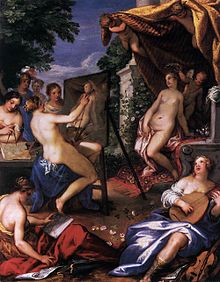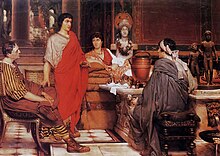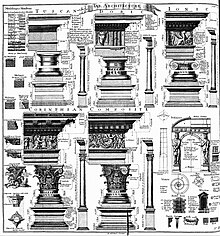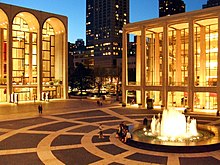The arts

The arts represent an outlet of human expression, usually influenced by culture, and driven by human creative impulse. Major constituents of the arts include literature – including poetry, novels and short stories, and epics; performing arts – among them music, dance, and theatre; culinary arts such as baking, chocolatiering, and winemaking; media arts like photography and film, and visual arts – including drawing, painting, and sculpting. Some art forms combine a visual element with performance (e.g. film) and the written word (e.g. comics).
From prehistoric cave paintings to modern day films, art serves as a vessel for storytelling and conveying mankind's relationship with its environment.
Definition
In its most basic abstract definition, art is a documented expression of a sentient being through or on an accessible medium so that anyone can view, hear or experience it. The act itself of producing an expression can also be referred to as a certain art, or as art in general.
If this solidified expression, or the act of producing it, is 'good' or worth anything depends on those who access and rate it and this public rating is dependent on various subjective factors.
Collins English Dictionary defines 'the arts' as "imaginative, creative, and nonscientific branches of knowledge considered collectively, esp. as studied academically".[1] The singular term art is defined by the Irish Art Encyclopedia as follows: "Art is created when an artist creates a beautiful object, or produces a stimulating experience that is considered by his audience to have artistic merit."[2] The same source states:
Art is a global activity which encompasses a host of disciplines, as evidenced by the range of words and phrases which have been invented to describe its various forms. Examples of such phraseology include: Fine Arts, Liberal Arts, Visual Arts, Decorative Arts, Applied Arts, Design, Crafts, Performing Arts, and so on.
History
Ancient Greek art brought the veneration of the animal form and the development of equivalent skills to show musculature, poise, beauty and anatomically correct proportions. Ancient Roman art depicted gods as idealized humans, shown with characteristic distinguishing features (i.e. Zeus' thunderbolt).
In Byzantine and Gothic art of the Middle Ages, the dominance of the church insisted on the expression of biblical and not material truths.
Eastern art has generally worked in a style akin to Western medieval art, namely a concentration on surface patterning and local colour (meaning the plain colour of an object, such as basic red for a red robe, rather than the modulations of that colour brought about by light, shade and reflection). A characteristic of this style is that the local colour is often defined by an outline (a contemporary equivalent is the cartoon). This is evident in, for example, the art of India, Tibet and Japan.
Religious Islamic art forbids iconography, and expresses religious ideas through geometry instead.
The physical and rational certainties depicted by the Enlightenment in the late 17th and 18th centuries were shattered not only by new discoveries of relativity by Einstein [1], the development of the quantum mechanics – in the words of Richard Feynman, quantum mechanics deals with "nature as She is, absurd"[3] – and of unseen psychology by Freud [2], but also by unprecedented technological development. Paradoxically the expressions of new technologies were greatly influenced by the ancient tribal arts of Africa and Oceania, through the works of Paul Gauguin and the Post-Impressionists, Pablo Picasso and the Cubists, as well as the Futurists and others.
Disciplines

In the Middle Ages, the Artes Liberales (liberal arts) were taught in universities as part of the Trivium – an introductory curriculum involving grammar, rhetoric, and logic[4] – and of the Quadrivium – a curriculum involving the “mathematical arts” of arithmetic, geometry, music, and astronomy.[4] The Artes Mechanicae (mechanical arts, such as vestiaria -tailoring, weaving-, agricultura -agriculture-, architectura -architecture, masonry-, militia and venatoria -warfare and hunting, "martial arts"-, mercatura -trade, commerce-, coquinaria -cooking-, and metallaria -blacksmithing, metallurgy – division made, somewhat arbitrarily, by Johannes Scotus Eriugena, already in the 9th century)[5] were practiced and developed in guild environments. The modern distinction between "artistic" and "non-artistic" skills did not develop until the Renaissance.
In modern academia, the arts are usually grouped with or as a subset of the Humanities. Some subjects in the Humanities are history, linguistics, literature, and philosophy. Newspapers typically include a section on the arts.
Traditionally, the arts are classified as seven although the list has been expanded to nine. These being Architecture, Sculpture, Painting, Music, Poetry, Dance, Theater/Cinema, with the modern additions of Photography[6] and Comics.[7]
Visual arts
Drawing
Drawing is a means of making an image, using any of a wide variety of tools and techniques. It generally involves making marks on a surface by applying pressure from a tool, or moving a tool across a surface. Common tools are graphite pencils, pen and ink, inked brushes, wax color pencils, crayons, charcoals, pastels, and markers. Digital tools which can simulate the effects of these are also used. The main techniques used in drawing are: line drawing, hatching, crosshatching, random hatching, scribbling, stippling, and blending. An artist who excels in drawing is referred to as a draftswoman or draughtsman. Drawings are used to create comics and animation for example.
Painting

Painting taken literally is the practice of applying pigment suspended in a vehicle (or medium) and a binding agent (a glue) to a surface (support) such as paper, canvas, wood panel or a wall. However, when used in an artistic sense it means the use of this activity in combination with drawing, composition and other aesthetic considerations in order to manifest the expressive and conceptual intention of the practitioner. Painting is also used to express spiritual motifs and ideas; sites of this kind of painting range from artwork depicting mythological figures on pottery to The Sistine Chapel to the human body itself.
Colour is the essence of painting as sound is of music. Colour is highly subjective, but has observable psychological effects, although these can differ from one culture to the next. Black is associated with mourning in the West, but elsewhere white may be. Some painters, theoreticians, writers and scientists, including Goethe, Kandinsky, Newton, have written their own colour theory. Moreover, the use of language is only an abstraction for a colour equivalent. The word "red", for example, can cover a wide range of variations on the pure red of the spectrum. There is not a formalized register of different colours in the way that there is agreement on different notes in music, such as C or C#, although the Pantone system is widely used in the printing and design industry for this purpose.
Modern artists have extended the practice of painting considerably to include, for example, collage. This began with Cubism and is not painting in strict sense. Some modern painters incorporate different materials such as sand, cement, straw or wood for their texture. Examples of this are the works of Jean Dubuffet or Anselm Kiefer.
Modern and contemporary art has moved away from the historic value of craft in favour of concept; this has led some to say that painting, as a serious art form, is dead, although this has not deterred the majority of artists from continuing to practise it either as whole or part of their work.
Photography
Photography as an art form refers to photographs that are created in accordance with the creative vision of the photographer. Art photography stands in contrast to photojournalism, which provides a visual account for news events, and commercial photography, the primary focus of which is to advertise products or services.
Architecture

Architecture is the art and science of designing buildings and structures. The word architecture comes from the Greek arkhitekton, "master builder, director of works," from αρχι- (arkhi) "chief" + τεκτων (tekton) "builder, carpenter".[8]
A wider definition would include the design of the built environment, from the macrolevel of town planning, urban design, and landscape architecture to the microlevel of creating furniture. Architectural design usually must address both feasibility and cost for the builder, as well as function and aesthetics for the user.

In modern usage, architecture is the art and discipline of creating an actual, or inferring an implied or apparent plan of any complex object or system. The term can be used to connote the implied architecture of abstract things such as music or mathematics, the apparent architecture of natural things, such as geological formations or the structure of biological cells, or explicitly planned architectures of human-made things such as software, computers, enterprises, and databases, in addition to buildings. In every usage, an architecture may be seen as a subjective mapping from a human perspective (that of the user in the case of abstract or physical artifacts) to the elements or components of some kind of structure or system, which preserves the relationships among the elements or components.
Planned architecture manipulates space, volume, texture, light, shadow, or abstract elements in order to achieve pleasing aesthetics. This distinguishes it from applied science or engineering, which usually concentrate more on the functional and feasibility aspects of the design of constructions or structures.
In the field of building architecture, the skills demanded of an architect range from the more complex, such as for a hospital or a stadium, to the apparently simpler, such as planning residential houses. Many architectural works may be seen also as cultural and political symbols, and/or works of art. The role of the architect, though changing, has been central to the successful (and sometimes less than successful) design and implementation of pleasingly built environments in which people live.
Conceptual art
Conceptual art is art in which the concept(s) or idea(s) involved in the work that takes precedence over traditional aesthetic and material concerns. The inception of the term in the 1960s, referred to a strict and focused practice of idea-based art that often defied traditional visual criteria associated with the visual arts in its presentation as text. Through its association with the Young British Artists and the Turner Prize during the 1990s, its popular usage, particularly in the UK, developed as a synonym for all contemporary art that does not practise the traditional skills of painting and sculpture.[9]
Literary arts

Literature is literally "acquaintance with letters" as in the first sense given in the Oxford English Dictionary. The noun "literature" comes from the Latin word littera meaning "an individual written character (letter)". The term has generally come to identify a collection of writings, which in Western culture are mainly prose (both fiction and non-fiction), drama and poetry. In much, if not all of the world, the artistic linguistic expression can be oral as well, and include such genres as epic, legend, myth, ballad, other forms of oral poetry, and as folktale. Literary arts and creative writing are interchangeable terms.[10]
Comics, the combination of drawings or other visual arts with narrating literature, are often called the "ninth art" (le neuvième art) in Francophone scholarship.
Performing arts

Between the Plastic Arts and the Performing Arts there are some methodological differences. To create its artistic purpose, that generally is an experience, the performing artist mainly uses its own body, face, or presence. The artistic purpose of a plastic artist normally is an object, and she or he uses materials (such as clay, metal or paint) to create it.
Performing arts include acrobatics, busking, comedy, dance, magic, music, opera, operetta, film, juggling, martial arts, marching arts such as brass bands and theatre.
Artists who participate in these arts in front of an audience are called performers, including actors, magicians, comedians, dancers, musicians, and singers. Performing arts are also supported by the services of other artists or essential workers, such as songwriting and stagecraft.
Performers often adapt their appearance, with costumes and stage makeup, etc.
There is also a specialized form of fine art in which the artists perform their work live to an audience. This is called Performance art. Dance was often referred to as a plastic art during the Modern dance era.
Music

Music is an art form whose medium is sound. Common elements of music are pitch (which governs melody and harmony), rhythm (and its associated concepts tempo, meter, and articulation), dynamics, and the sonic qualities of timbre and texture. The creation, performance, significance, and even the definition of music vary according to culture and social context. Music ranges from strictly organized compositions (and their reproduction in performance), through improvisational music to aleatoric forms. Music can be divided into genres and subgenres, although the dividing lines and relationships between music genres are often subtle, sometimes open to individual interpretation, and occasionally controversial. Within "the arts", music may be classified as a performing art, a fine art, and auditory art.
Theatre
Theatre or theater (from Greek theatron – θέατρον – from theasthai, "behold") is the branch of the performing arts concerned with acting out stories in front of an audience using combinations of speech, gesture, music, dance, sound and spectacle – indeed any one or more elements of the other performing arts. In addition to the standard narrative dialogue style, theatre takes such forms as opera, ballet, mime, kabuki, classical Indian dance, Chinese opera and mummers' plays.
Dance

Dance (from Old French dancer [verb], dance [noun], of unknown origin)[11] generally refers to human movement either used as a form of expression or presented in a social, spiritual or performance setting.
Dance is also used to describe methods of non-verbal communication (see body language) between humans or animals (bee dance, mating dance), motion in inanimate objects (the leaves danced in the wind), and certain musical forms or genres.
Choreography is the art of making dances, and the person who does this is called a choreographer. People danced to relieve stress.
Definitions of what constitutes dance are dependent on social, cultural, aesthetic, artistic and moral constraints and range from functional movement (such as Folk dance) to codified, virtuoso techniques such as ballet. In sports, gymnastics, figure skating and synchronized swimming are dance disciplines while Martial arts 'kata' are often compared to dances.
Video games
A debate exists in the fine arts and video game cultures over whether video games can be counted as an art form.[12] Game designer Hideo Kojima, professes that video games are a type of service, not an art form.[13] Art theorist Denis Dutton wrote: "Fans also overrate the contribution of video games to storytelling as an art form. Video games are complicated and visually arresting forms of make-believe that allow the viewers to jump into the stage and participate in the action. This is regarded by the video-game enthusiast as an earth-shaking advance. In a way, it is less an extension of storytelling art than a regression to its precursors. While the themes and content of the video game may be complex and adult, the logic of viewer participation in the story reverts back to the child's tea party with teddy bears." [14]
In May 2011, the National Endowment of the Arts included video games in its redefinition of what is considered a work of art when applying of a grant.[15] In 2012, the Smithsonian American Art Museum presented an exhibit, The Art of the Video Game.[16] However, the reviews of the exhibit were mixed, including questioning whether video games belong in an art museum.[17][18]
Gastronomy
Gastronomy is the study of the relationship between culture and food. It is often thought erroneously that the term gastronomy refers exclusively to the art of cooking (see Culinary art), but this is only a small part of this discipline; it cannot always be said that a cook is also a gourmet. Gastronomy studies various cultural components with food as its central axis. Thus it is related to the Fine Arts and Social Sciences, and even to the Natural Sciences in terms of human nutritious activity and digestive function.
Arts criticism
- Architecture criticism
- Visual art criticism
- Dance criticism
- Film criticism
- Literary criticism
- Music journalism
- Television criticism
- Theatre criticism
See also
Notes
- ^ "Collins English Dictionary – Complete & Unabridged 11th Edition". Retrieved October 23, 2012.
- ^ http://www.visual-arts-cork.com/art-definition.htm#definition A Working Definition of Art (2009)
- ^ Richard P. Feynman, QED, p. 10
- ^ a b New Oxford American Dictionary.
- ^ Commentary on Martianus Capella's early fifth century work, Marriage of Philology and Mercury, one of the main sources for medieval reflection on the liberal arts.
- ^ Keppler, Victor (1938). A life of color photography: The eighth art. W. Morrow & Co. ASIN B00085HDEI.
- ^ Dierick, Charles (2000). Het Belgisch Centrum van het Beeldverhaal (in Dutch). Brussels: Dexia Bank / La Renaissance du Livre. p. 11. ISBN 2-8046-0449-7.
- ^ Online Etimology Dictionary.
- ^ Turner prize history: Conceptual art Tate gallery tate.org.uk. Accessed August 8, 2006
- ^ Department of Creative Writing and Literary Arts. University of Alaska Anchorage. Retrieved 30 May 2012.
- ^ New Oxford American Dictionary. Oxford University Press. Version 2.0.3 (51.5)
- ^ "From the Archives: Going Through Game Informer's Past". Game Informer (200): 83. December 2009.
- ^ "Kojima Says "Games Are Not Art"". Retrieved 2011-01-06. Kotaku (2006)
- ^ Dutton, Denis (2009). The Art Instinct: Beauty, Pleasure, and Human Evolution. New York: Bloomsbury Press. p. 133. ISBN 1-59691-401-7.
- ^ "FY 2012 ARTS IN MEDIA GUIDELINES". National Endowment for the Arts. 13 May 2011. Retrieved 02/12/2013.
{{cite web}}: Check date values in:|accessdate=(help) - ^ "The Art of Video Games". Smithsonian American Art Museum. March 16, 2012. Retrieved 02/12/2013.
{{cite web}}: Check date values in:|accessdate=(help) - ^ Barron, Christina (April 29, 2012). "Museum exhibit asks: Is it art if you push 'start'?". The Washington Post. Retrieved 02/12/2013.
{{cite news}}: Check date values in:|accessdate=(help) - ^ Kennicott, Philip (March 18, 2012). "The Art of Video Games". The Washington Post. Retrieved 02/12/2013.
{{cite news}}: Check date values in:|accessdate=(help)
References
- Does time fly? – Peter Galison's Empires of Time, a historical survey of Einstein and Poincare, intrigues Jon Turney. Jon Turney. The Guardian, Saturday 6 September 2003
- Contradictions of the Enlightenment: Darwin, Freud, Einstein
External links
- Cowan, Tyler (2008). "Arts". In David R. Henderson (ed.) (ed.). Concise Encyclopedia of Economics (2nd ed.). Indianapolis: Library of Economics and Liberty. ISBN 978-0865976658. OCLC 237794267.
{{cite encyclopedia}}:|editor=has generic name (help) – A look at how general economic principles govern the arts.
